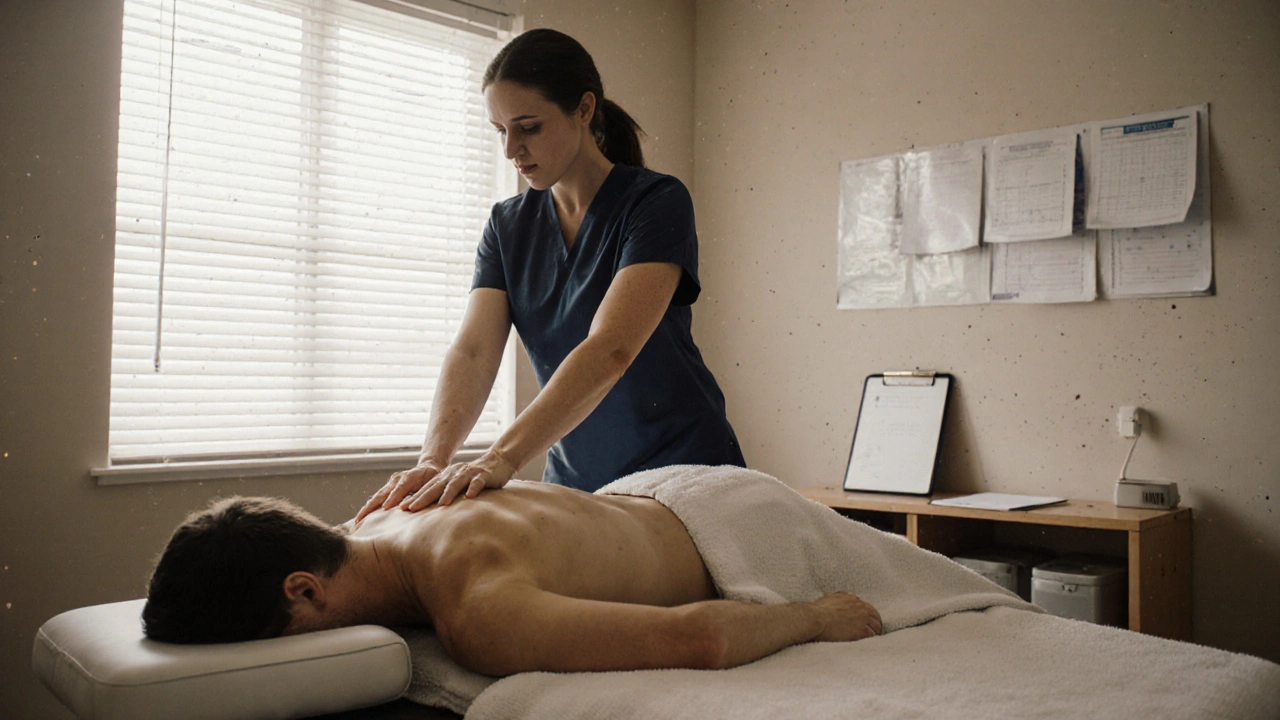Pain Relief: Practical Tips to Ease Pain Fast
Pain gets in the way of life—whether it’s your dog limping after a run or you dealing with a stiff neck. The good news: small, focused steps often cut pain and speed recovery. Below are hands-on therapies, simple daily habits, and clear signs for when to see a pro. Read this like a checklist you can actually use.
Hands-on therapies that often help
Massage is one of the fastest ways to calm pain. For athletes and active dogs, sports massage and neuromuscular work ease tight spots and help tissue recover. Myofascial release targets tight connective tissue and can free up movement after long-term stiffness. If you’re working with a dog, keep sessions short, use gentle pressure, and watch for signs of discomfort—ask a canine massage pro for guidance.
Trigger point work (a focused type of pressure on sore knots) can reduce referred pain—pain that shows up in places away from the actual problem. A trained therapist can find and treat those points safely. For home care, gentle rubbing, slow circular strokes, or using a soft ball for self-massage can give relief without causing more damage.
Daily habits that cut pain and speed healing
Move smart. Gentle, regular movement keeps joints lubricated and muscles flexible. Short walks, slow range-of-motion stretches, and low-impact activities (swimming for dogs and humans) reduce stiffness without overloading a sore area.
Fuel recovery. Omega-3s lower inflammation—add fatty fish, walnuts, or a vet-approved supplement for dogs. Balanced protein and enough calories help tissues repair faster. Avoid crash diets when healing from an injury; undernourished tissues heal slowly.
Use simple tools: a warm compress before activity loosens tight muscles; an ice pack after intense use can reduce swelling. For chronic tension, biofeedback tools and guided relaxation help you spot stress patterns and change them—this works well for headaches, jaw pain, and stress-related muscle tightness.
Sleep matters. Poor sleep raises pain sensitivity. Aim for consistent sleep and a calm bedtime routine. For dogs, a supportive bed and predictable schedule cut night-time pain flares.
When to call a professional: if pain is severe, sudden, getting worse, or causing limping, seek veterinary or medical care. Also get help if simple home strategies don’t reduce pain in a week or two. Therapies like targeted physical therapy, prescription meds, or guided biofeedback can make a big difference when home care isn’t enough.
Quick examples you can try today: for a stiff lower back, try 10 minutes of slow cat-cow stretches, a warm pack for five minutes, then gentle self-massage along the spine. For an older dog with hip pain, swap one long walk for two short walks, add omega-3s after checking with your vet, and book a session with a certified canine massage therapist.
Pain isn’t something you must just tolerate. Use targeted hands-on care, smarter daily choices, and professional help when needed. Small changes often equal big relief.

Ortho-Bionomy: How Your Body Heals Itself Through Gentle Movement
Ortho-Bionomy is a gentle, non-invasive bodywork method that helps your body heal itself by finding positions of comfort. It's effective for chronic pain, stress tension, and recovery without force or manipulation.

Rediscover Health and Wellness with Medical Massage
Medical massage is a targeted therapy for chronic pain, injury recovery, and mobility issues - not just relaxation. Learn how it works, who it helps, and how to find the right therapist.

Sports Massage Science: Boosting Athletic Recovery and Performance
Discover how sports massage works, what science says about its effects on your body, and get real tips for using massage to boost recovery and performance.

Cross Fibre Release: Incredible Benefits You Never Knew About
Cross fibre release is a hands-on technique aimed at breaking up scar tissue and easing stubborn knots in muscles. This article unpacks how it works and why so many athletes and desk workers swear by it. You’ll discover surprising health benefits, practical tips for trying it yourself, and mistakes to avoid. Whether you struggle with chronic pain or just want to move better, these insights will change how you approach muscle care.

Fascia Stretching: Unlock Your Body's Full Potential
Fascia stretching is about more than just touching your toes—it targets the connective tissue that holds everything in your body together. This article explains how fascia stretching can boost mobility, cut down on pain, and even help you recover from injury faster. You’ll get facts, practical tips, and a look at why your fascia matters more than most people think. Whether you’re a seasoned athlete or stiff from sitting at a desk, these techniques can upgrade how you move and feel. Start exploring the potential hidden beneath your skin.

Unseen Benefits of Myofascial Release: What You Need to Know
Dive into the world of myofascial release therapy and uncover its surprising benefits. This therapy isn't just about muscle relaxation; it addresses fascia, the intricate network beneath our skin, offering relief from chronic pain and improved mobility. Learn the science, get practical tips, and discover how regularly releasing fascia can enhance your daily life without needing fancy equipment or techniques.

Unlocking Natural Relief: The Benefits of Ortho-Bionomy
Ortho-Bionomy is a gentle and effective bodywork therapy that focuses on self-correction through alignment and relaxation techniques. Rooted in osteopathy principles, it uses the body's own intelligence to reduce tension, improve circulation, and enhance overall well-being. As a non-invasive treatment, Ortho-Bionomy is suitable for a wide range of individuals seeking holistic approaches to pain management and stress relief. This article explores its principles, benefits, and practical applications, offering insights into how it can be a vital part of healing and wellness.

Unlocking the Secrets of Trigger Point Massage Therapy
Trigger point massage is gaining popularity as a powerful method for alleviating chronic pain and muscle tension. This technique targets specific areas known as trigger points, which can cause discomfort and restrict movement. Through the application of pressure and manual manipulation, therapists help release tension and promote relaxation. Discover the benefits of this massage, the science behind its effectiveness, and tips for integrating it into your wellness routine.

Transforming Pain Relief with Trigger Point Massage Therapy
Trigger point massage has emerged as a groundbreaking technique in the field of pain relief. By targeting specific knots in the muscles, this form of massage therapy effectively alleviates pain, improves circulation, and enhances overall well-being. To understand its benefits, we explore what trigger points are, how this massage differs from other types, and provide practical tips for maximizing treatment effectiveness. Discover why trigger point massage is becoming a popular choice for those seeking a holistic approach to pain management.

The Art and Benefits of Palliative Massage Therapy
Palliative massage therapy offers essential care for those dealing with chronic illnesses or nearing the end of their lives. It combines the art of touch with science to provide physical and emotional relief. This method helps manage pain, anxiety, and other symptoms, enhancing the quality of life for patients and their families.

Exploring the Wonders of Snail Facial Massage
Oct, 10 2023



